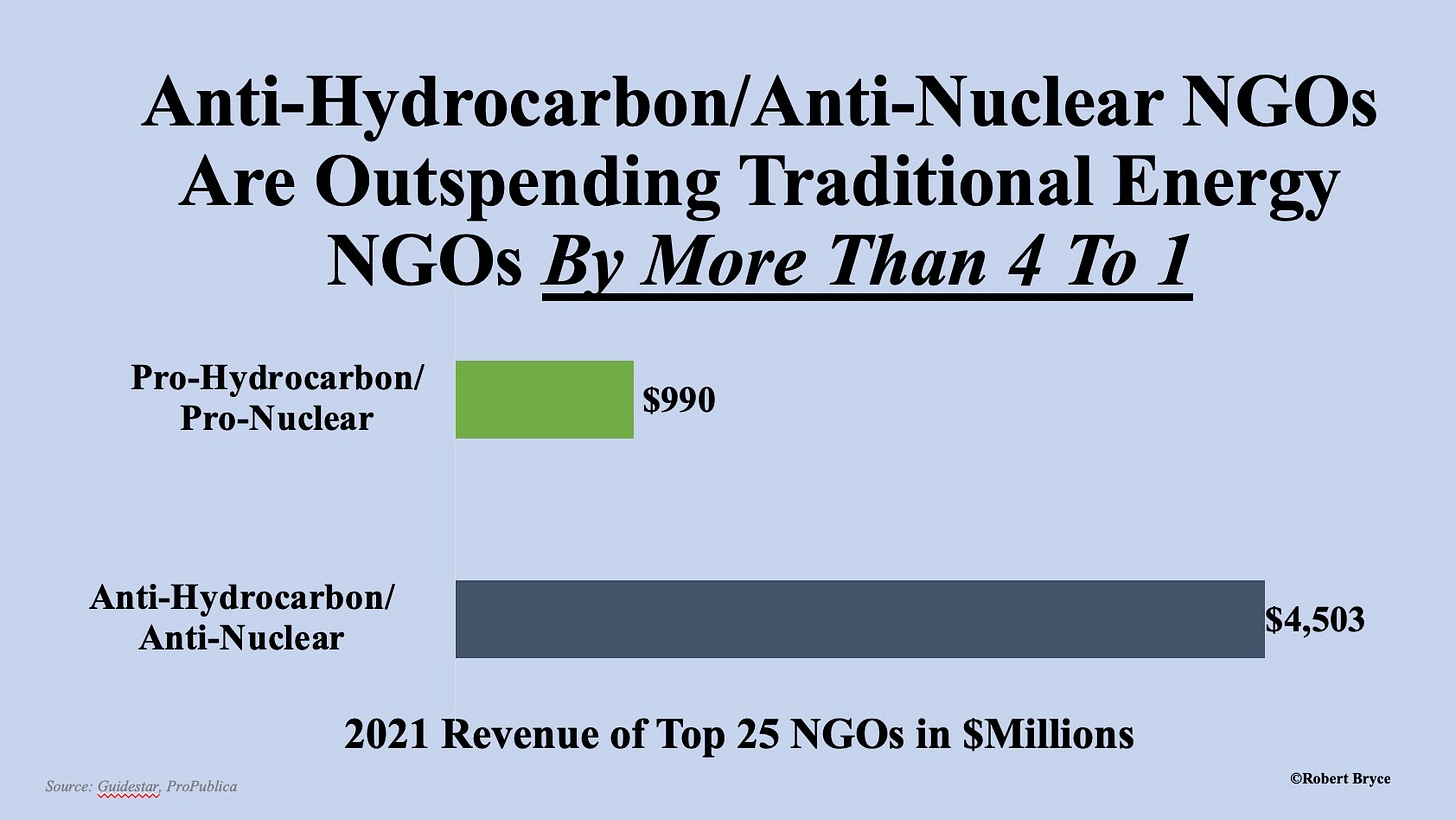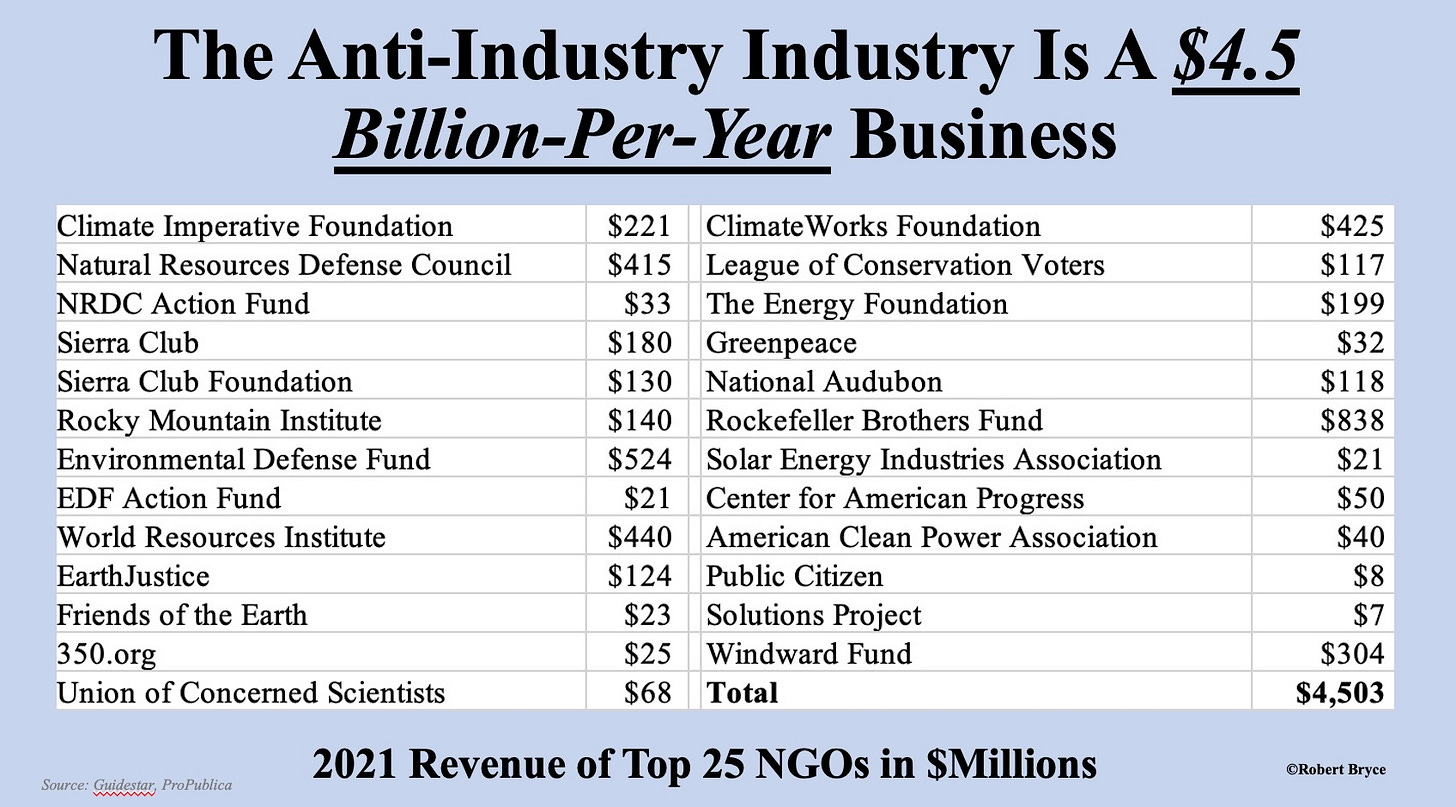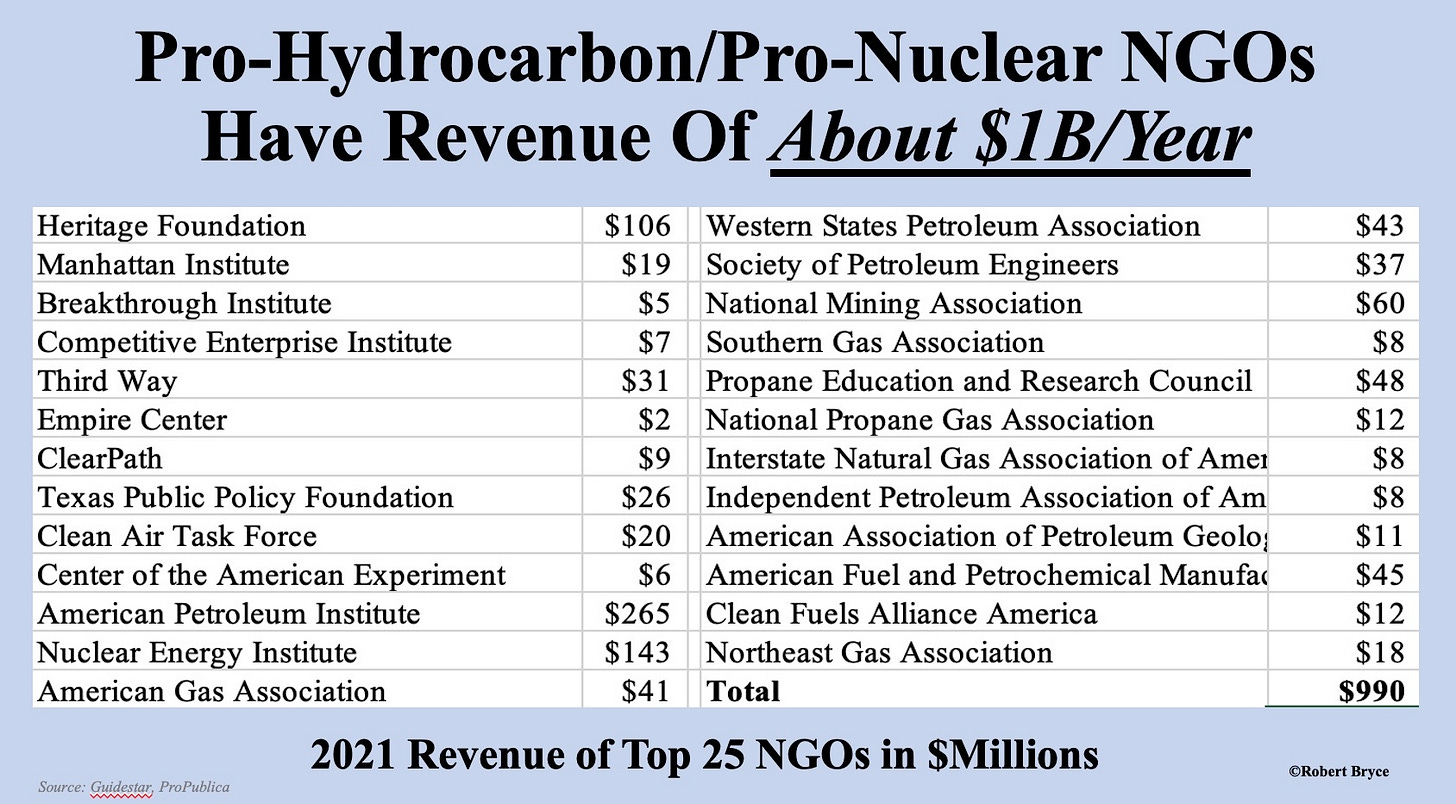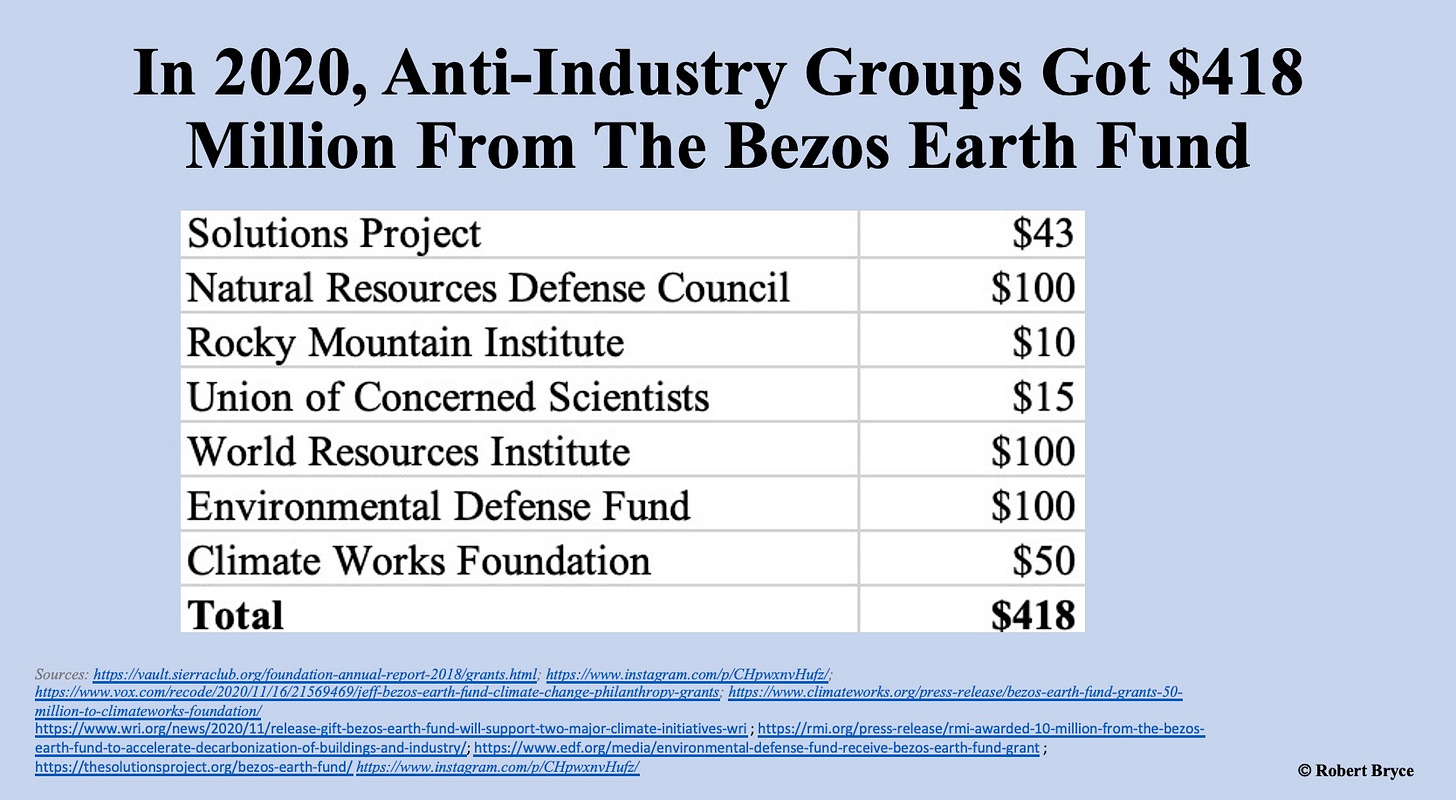The Anti-Industry Industry
The Anti-Industry Industry
What the media won’t tell you about the $4.5 billion-per-year NGO-corporate-industrial-climate complex.
The overwhelming majority of the money involved in the energy and climate debate in the U.S. today is not on the side of traditional energy producers. Instead, the money, the media, and the momentum are clearly on the side of the NGO-corporate-industrial-climate complex.
In 2021, the revenue for the top 25 NGOs in the anti-industry industry was more than four times the amount collected by NGOs that support the traditional energy sector. Those 25 anti-hydrocarbon/anti-nuclear NGOs had total revenue of about $4.5 billion which they used to fund campaigns on climate change, as well as efforts to promote renewable energy, stop the production of hydrocarbons, halt construction of new hydrocarbon infrastructure, prohibit the use of natural gas, oppose nuclear energy, and electrify everything, a move that would require massive increases in electricity production and the size of the electric grid.
The $4.5 billion sum, which I tallied over the past few weeks by compiling data from Guidestar and ProPublica, is more than four times the amount being raised by the top 25 NGOs that are either pro-hydrocarbon or pro-nuclear. In 2021, the top 25 non-profit associations that represent hydrocarbon producers, the nuclear energy industry—along with their allies in the think tank sector—took in about $990 million, or less than one-fourth of the amount garnered by the top anti-hydrocarbon/anti-nuclear NGOs. As can be seen in the graphic above, 14 of the anti-hydrocarbon/anti-nuclear NGOs have annual revenues of more than $100 million. By comparison, as can be seen in the graphic below, only three of the NGOs on the other side of the policy divide have revenues of more than $100 million.
Furthermore, the amount of money being collected by the top anti-hydrocarbon/anti-nuclear NGOs is soaring. Between 2017 and 2021, the amount of cash being collected by the 25 top NGOs—which includes entities like the Sierra Club and Environmental Defense Fund—has jumped by 155%, going from about $1.8 billion to $4.5 billion.
Don’t expect to read about this vast funding disparity in legacy media outlets. Some of the biggest news organizations in America are peddling a manufactured narrative that the growth of renewable energy is being hindered by “front groups” that are getting money from hydrocarbon producers. In December, in The New Yorker, climate activist Bill McKibben claimed “front groups sponsored by the fossil-fuel industry have begun sponsoring efforts to spread misinformation about wind and solar energy.” But McKibben didn’t bother to name a single such group. Also in December, the New York Times published an article that claimed the opposition to wind projects in Michigan included “anti-wind activists with ties to groups backed by Koch Industries.” But the reporter who wrote the article, David Gelles, didn’t provide any names or any proof of any Koch connections. (Gelles did not reply to two emails asking him for proof of his claim.)
National Public Radio has published several articles claiming that rural opposition to renewables is being fostered by opponents who are using “misinformation.” Last year, a San Francisco-based reporter, Julia Simon, published an article that claimed: “some of the misinformation comes from groups with ties to the fossil fuel industry, like the Texas Public Policy Foundation.” (2021 revenue: $26 million). But Simon didn’t provide an example to back up her claim.
Why won’t McKibben and NPR report honestly about the rural backlash to the landscape-destroying sprawl of renewable energy or the funding that drives the NGO-corporate-industrial-climate complex? The answer may be about funding. Since 2019, 350.org, the climate-activist group that McKibben co-founded, (and has about 160 staffers) has received more than $400,000 from the Rockefeller Brothers Fund.
NPR is feeding at the same trough as the other NGOs. NPR is a non-profit. According to Guidestar, its 2021 revenues totaled $456 million. Last September, NPR announced that it was opening a new “climate desk” that was being funded by “the Chan Zuckerberg Initiative, whose funding is helping NPR to add a new Climate Solutions reporter, as well as The Rockefeller Foundation.”
My interest in the anti-industry industry is a continuation of the work I did for my January 26 article, “The Billionaires Behind The Gas Bans,” which is the most popular piece I’ve published on Substack. The numbers presented here are my best effort at collecting accurate data.
Before going further, let me be clear: I am not claiming that my lists of the top 25 NGOs on either side of the energy policy divide are the definitive ones. Some of the NGOs that are pro-hydrocarbon are not pro-nuclear. This week, a prominent pro-nuclear activist reminded me that over the past decade, some pro-hydrocarbon NGOs fought policies that would have helped save nuclear plants from premature closure. Selecting the anti-industry NGOs was also complicated. A keyword search for “climate change” turned up more than 7,500 entries in ProPublica’s Nonprofit Explorer database. For my top 25 lists, I chose the NGOs that I knew about or had the highest profiles.
Let me also be clear about the revenue figures. The numbers are mostly from 2021 and come primarily from Guidestar's free search feature. I also used ProPublica’s free database. (A full subscription to Guidestar costs $2,000.) The numbers are what Guidestar calls “gross receipts.” Those figures may differ from the revenue numbers shown on the Form 990s filed by the NGOs. Thus, the revenue tallies may be somewhat higher, or somewhat lower, than what is shown here.
But even with those caveats, the results are undeniable: the anti-industry industry in America is enormous, its revenues are soaring, and its success in getting local and state governments to adopt anti-hydrocarbon policies is obvious. Indeed, the pro-hydrocarbon and pro-nuclear entities in America are outgunned and outmanned. And when it comes to policymaking, they are getting their collective butts kicked.
Efforts to ban gas stoves are only a small part of a broader agenda that aims to change the fuels we use, where we live, and what we drive. The anti-industry industry has already succeeded in banning the direct use of natural gas in homes and businesses in communities across the country. According to the Sierra Club, 74 communities in California have “adopted gas-free buildings commitments or electrification building codes.” That’s a significant increase over what I reported last month. On January 26, when I published “The Billionaires Behind The Gas Bans,” that number was 69. In September, the California Air Resources Board voted to ban the sale of all natural gas-fired space heaters and water-heating appliances in the state by 2030. In addition, New York City and Seattle, have banned the use of gas in new construction. Massachusetts is rolling out a measure that will allow up to 10 communities to ban gas. But these efforts are only part of what can only be called a radical agenda.
What is that agenda? Consider this statement from the Natural Resources Defense Council, which according to Guidestar has annual revenue of about $415 million. In 2020, it said it would use a $100 million grant from the Bezos Earth Fund to “advance climate solutions and legislation at the state level, [and] move the needle on policies and programs focused on reducing oil and gas production.” Or consider EarthJustice, (2021 budget: $124 million) which says its goals include “End the extraction and burning of fossil fuels...power everything with 100% clean energy...[and] cultivating a zero carbon emissions pollution-free electricity grid by phasing out fossil fuel power generation, eliminating barriers to renewable energy, and more.”
In short, while their activism is couched in language about climate change and climate justice, the goal of the “climate aristocracy” (a term coined by Decouple podcast host and pro-nuclear activist Chris Keefer) is to shut down the hydrocarbon sector. If the climate aristocracy succeeds in doing so, the results will be staggering increases in energy costs and dangerous decreases in the reliability and resilience of our electric grid.
Indeed, the surge in the size and funding of the anti-industry industry represents a threat to the long-term prosperity of the United States. Its policies are already imposing regressive energy taxes on the poor and the middle class. The anti-industry industry is yet another sign of America’s decadence. It’s an unaccountable parasitic force that employs thousands of lawyers, strategists, pollsters, and fundraisers, many of whom will spend their careers treading the revolving door between academia, media, government, and the NGOs. It relies on technocrats who went to exclusive universities, live in heavily Democratic coastal cities, have never been to Branson, and don’t give a fuck about the people who live in flyover country, wear name tags at work, or turn wrenches for a living.
Demographer and author Joel Kotkin calls these elites the “clerisy.” And they are influencing energy policy at the local, state, and federal levels with budgets that are unprecedented in scope, and in many cases, purposely hidden from public scrutiny.
“This is a class issue on a lot of levels,” Kotkin told me. “Climate change is to neo-feudalism what Catholic dogma was in the Middle Ages. It’s a justification for autocracy…[We now have] a class of people with a lot of money who have no connection to the real economy. The price of gasoline and electricity doesn’t matter to them.”
“This is a class issue on a lot of levels,” Kotkin told me during a recent phone interview. “Climate change is to neo-feudalism what Catholic dogma was in the Middle Ages. It’s a justification for autocracy. The climate agenda plays the same roles today as Catholic dogma did back then. There are things you can’t say because it questions the dogma.”
Kotkin also underscored the fact that hundreds of millions of dollars in funding for the anti-industry industry is coming from some of the world’s richest people (a point that I made in “The Billionaires Behind The Gas Bans”) and that these billionaires—and the groups they are funding—do not represent the broader society. Kotkin said these outcomes were predicted by Daniel Bell in his landmark 1973 book, The Coming of Post-Industrial Society: A Venture in Social Forecasting, which warned that as societies became detached from industrial production, a new group of elites would become detached from the general population. “This is what Bell talked about,” he said. We now have “A class of people with a lot of money who have no connection to the real economy. The price of gasoline and electricity doesn’t matter to them.”
One of the biggest funders of the anti-industry industry is Jeff Bezos. In 2020, the Bezos Earth Fund gave more than $400 million to seven of the groups that are on my list of the top 25 anti-hydrocarbon/anti-nuclear NGOs in America.
The NGO with the biggest climate-related budget is the Rockefeller Brothers Fund, which according to Guidestar had revenue of $823 million in 2021. On its website, the fund states, “In 2023, climate-related grants—including the full Sustainable Development, Democratic Practice–Global Challenges, and China grantmaking programs, as well as portions of our Central America and Western Balkans grantmaking—will constitute just under 50 percent of the Fund’s total grantmaking budget.” It continues, “In November 2022, the RBF board of trustees adopted a plan to spend an additional $100 million to address the climate crisis over the next ten years.”
Also, from the RBF website: “In the 1970s, the Fund began supporting the environmental law movement through grants to the Natural Resources Defense Council (NRDC). Laurance’s son, attorney Laurance Rockefeller, Jr., worked at NRDC for over 25 years and continues to serve as an NRDC trustee in 2016.”
It’s critical to note that the NRDC has been one of the most vocal anti-nuclear NGOs in America and was a critical player in the premature closure of New York’s Indian Point nuclear plant, a closure that immediately resulted in huge increases in New York consumers’ electric bills and a dramatic increase in the state’s greenhouse gas emissions. Rockefeller entities have also been key funders of the litigation against the oil industry.
A few more points are relevant here. First, the size of the NGO-corporate-industrial-climate complex in the United States dwarfs the size of similar entities in Canada, where climate-focused entities are tiny. As can be seen in the chart above, the top five Canadian climate groups have total combined budgets of about C$33 million, which is about $25 million in U.S. currency. Thus, all of those Canadian climate NGOs combined would only amount to a relatively small member of the anti-industry industry in the U.S.
In addition to their advantages in money and media sympathy, the anti-industry industry has other key advantages over the traditional energy sector, and those advantages help explain why it has been so successful in promulgating policies like gas bans. First, the climate clerisy continually sells fear: fear of catastrophic climate change, fear of radiation, and fear of fracking. On that last fear, consider this line from a press release issued by the NRDC in 2020: “We banned fracking in New York and it’s time long past time [sic] to block its waste from poisoning communities.”
The other key advantage held by the anti-industry industry is that it has a far easier chore than what has to be done by traditional energy providers. Electric utilities, cooperatives, drillers, refiners, natural gas producers, gas distributors, and pipeline companies have to deliver molecules and electrons to their customers. And they have to do it every minute of the day, every day of the year, and they have to keep doing it regardless of the policy hurdles that may be put in their way. On the other side, groups like the Sierra Club and Rocky Mountain Institute only have to get their policies adopted by governments.
In short, it’s a lot easier to convince the Berkeley City Council to adopt a ban on natural gas than it is to deliver that fuel and do so reliably and affordably to thousands (or millions) of homes and businesses. Put another way, the NGO-corporate-industrial-climate complex has launched an asymmetric war against the hydrocarbon and nuclear-energy sectors. And so far it is having undeniable success. The climate aristocracy—from its strongholds in New York City, Washington D.C., San Francisco, and Boston—only has to get policies passed. When it does so, it can return to its deep-pocketed funders and ask for yet more money. The climate aristocrats don’t have to deliver anything of tangible value (tankers of diesel fuel, decatherms of gas, or kilowatt-hours) in the physical world. That helps explain why the traditional energy sector is getting its collective butt kicked in the policy arena.
There is far more to be written about the NGO-corporate-industrial-climate complex and its influence on American energy policy. In a future post, I will focus on the anti-industry industry’s dark money machine.
Source: Robert Bryce





Comments
Post a Comment